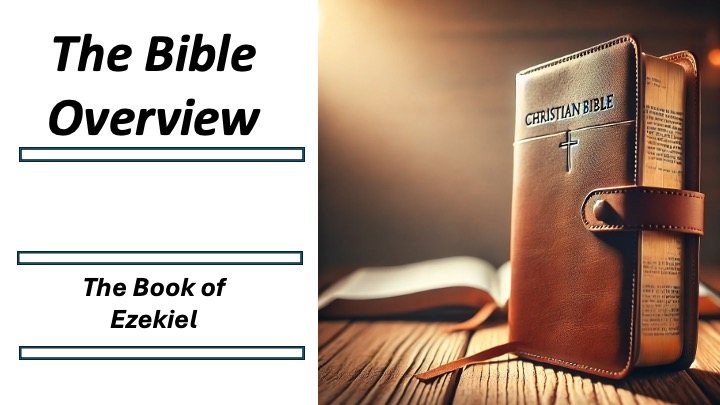Bible Overview Ezekiel
Mike Ervin

Authorship of Ezekiel
Traditional View
The traditional view holds that the prophet Ezekiel, son of Buzi, authored the
book. He was a priest taken into exile in Babylon around 597 BCE during the
second deportation under Nebuchadnezzar. His prophetic ministry lasted from
approximately 593 to 571 BCE. The book is written in the first person, with
frequent references to divine visions and personal experiences, supporting the
belief that Ezekiel himself wrote or dictated the text.
Modern Scholarly View
Modern scholars generally accept Ezekiel as a historical figure but debate the
book’s composition. Many argue that while the core prophecies likely originate
from Ezekiel, the final form of the book underwent editorial shaping, possibly
by later disciples or scribes. Some linguistic and structural analyses suggest
additions or refinements over time. However, there is little dispute that the
material originates from the exilic period.
⸻
Date of Authorship
Traditional View
The book is traditionally dated between 593 and 571 BCE, based on internal
chronological markers that correspond to the years of Ezekiel’s prophetic
ministry during the Babylonian exile.
Modern Scholarly View
Most scholars agree that the book was written during or shortly after the
Babylonian exile, roughly between the early 6th and late 5th century BCE. Some
suggest a final editorial process in the Persian period (5th century BCE), but
the bulk of the material is considered exilic.
⸻
Main Themes in Ezekiel
1. The Glory of God (Shekinah) – Ezekiel’s visions emphasize God’s transcendent
glory, particularly in the opening vision (Ezekiel 1) and the departure of
God’s glory from the Temple (Ezekiel 10–11).
2. Judgment on Judah and Jerusalem – The first part of the book (chapters 1–24)
focuses on the inevitability of Jerusalem’s destruction due to Israel’s sins.
3. Judgment on the Nations – Ezekiel prophesies against surrounding nations
(chapters 25–32) for their arrogance and mistreatment of Israel.
4. Hope and Restoration – After Jerusalem falls, Ezekiel shifts toward messages
of renewal, including the vision of the dry bones (Ezekiel 37) and the promise
of a new Temple (Ezekiel 40–48).
5. Individual Responsibility – Unlike earlier collective views of sin and
punishment, Ezekiel emphasizes personal accountability before God (Ezekiel 18).
6. The New Covenant and the Spirit – The book anticipates a time when God will
give His people a new heart and a new spirit (Ezekiel 36).
⸻
Sequential Summary of Ezekiel
1. Ezekiel’s Call and Commission (Chapters 1–3)
• Chapter 1: Vision of God’s glory—Ezekiel sees the famous chariot throne with
four living creatures.
• Chapter 2: God calls Ezekiel to be a prophet to rebellious Israel.
• Chapter 3: Ezekiel eats a scroll symbolizing his message; he is appointed as
a watchman over Israel.
2. Judgment on Jerusalem and Judah (Chapters 4–24)
• Chapters 4–5: Symbolic acts depicting Jerusalem’s siege and destruction.
• Chapters 6–7: Judgment against idolatry and the land’s devastation.
• Chapters 8–11: Ezekiel sees abominations in the Temple, leading to God’s
glory departing from Jerusalem.
• Chapters 12–19: Further symbolic acts and warnings, including the parable of
the vine and the principle of individual responsibility (Chapter 18).
• Chapters 20–24: Final warnings, including the allegory of the unfaithful wife
(Chapter 23) and the parable of the boiling pot (Chapter 24).
3. Judgment on the Nations (Chapters 25–32)
• Prophecies against Ammon, Moab, Edom, Philistia, Tyre, Sidon, and Egypt.
• The fall of Tyre is described in great detail (Chapters 26–28).
• Lamentations over Egypt’s downfall (Chapters 29–32).
4. Hope for Israel’s Restoration (Chapters 33–39)
• Chapter 33: Ezekiel as the watchman, transition from judgment to restoration.
• Chapter 34: Condemnation of Israel’s shepherds (leaders) and the promise of a
true Shepherd.
• Chapter 36: The promise of a new heart and Spirit.
• Chapter 37: The vision of the valley of dry bones, symbolizing Israel’s
national resurrection.
• Chapters 38–39: Prophecy of Gog and Magog—future enemies who will be defeated
by God.
5. The Vision of the New Temple and Restored Worship (Chapters 40–48)
• Chapters 40–42: Ezekiel sees a detailed vision of a new Temple.
• Chapter 43: God’s glory returns to the Temple.
• Chapters 44–46: Instructions for priests and worship.
• Chapters 47–48: The restored land and division among the tribes. The book
ends with a vision of a new Jerusalem, called “The LORD is There.”
⸻
Conclusion: The Importance of Ezekiel
The book of Ezekiel is significant for several reasons:
1. Theological Contribution – It deepens the understanding of God’s holiness,
sovereignty, and presence among His people.
2. Exilic Perspective – It speaks to a people in crisis, offering both judgment
and hope.
3. Messianic and Eschatological Foreshadowing – Themes such as the new heart,
the Good Shepherd, and the restoration of Israel anticipate New Testament
teachings.
4. Apocalyptic Imagery – Ezekiel’s visions influence later Jewish and Christian
apocalyptic literature, including the Book of Revelation.
Ezekiel’s message of personal responsibility, divine justice, and ultimate
restoration remains relevant, speaking to both individual and communal faith.